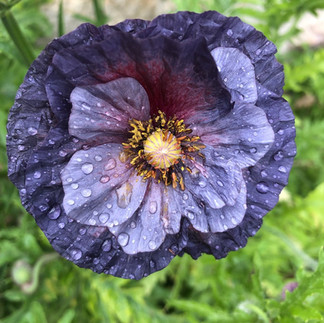Cold-Hardy Annuals: The Unsung Heroes of the Mixed Border
- Simone Taylor
- Apr 29
- 3 min read
When we think about borders in the garden, perennials and shrubs often come to mind first. They’re the reliable backbone—returning year after year, creating structure and continuity. But there’s another group of plants that deserves more consideration, especially for gardeners who have a new border or crave long-lasting color, texture, and resilience and that is cold-hardy annuals.
What Exactly Are Cold-Hardy Annuals?
Cold-hardy annuals, also called Cool Flowers are plants that complete their life cycle in one season but can tolerate frost (and even light snow). They thrive in cooler temperatures, often germinate in autumn or very early spring, and bloom well before tender summer annuals. Think of them as the tall early risers of the border, just after the shorter spring bulbs.
Why Use Them in a Mixed Border?
Mixed borders thrive on variety—contrasts in color, texture, height, and seasonal interest. Here’s where cold-hardy annuals can fill a gap:
1. Early Season Color
Many mixed borders look bare or sleepy in early spring. Cold-hardy annuals like Poppies, Corn Cockle, Calendula, Ammi, Corn Flower and Cerinthe can start blooming while the perennials are still waking up. These plants fill the gaps beautifully and help extend your garden’s visual interest from early spring through to summer.
2. Seamless Transitions
Once the cold-hardy annuals begin to fade in the heat of summer, the warm-season perennials and shrubs are hitting their stride. That means no awkward “off-season” look in the border—just smooth transitions with succession from one flower to the next. Plus, many cold-hardy annuals reseed, returning next year in new interesting spots.
3. Texture and Movement
With feathery foliage, or tall dainty blooms cold-hardy annuals offer a range of textures that can soften rigid perennial or complement bolder foliage. Think of ammi (false Queen Anne’s lace) swaying beside Peonies or Corn Flowers tucked in near Grasses. They add a layer of grace and informality that’s hard to beat.
4. Budget-Friendly Abundance
Cold-hardy annuals are one of the most cost-effective ways to bulk up a mixed border. A few self seeding annuals, a bit of planning, and you’ll have dozens of plants that fill out your border beautifully.
5. Great cut flowers
Most cold hardy annuals make great cut flowers, so any excess blooms cat be brought inside to brighten the house in those lengthening days of spring.
5. Fillers for young borders
Cold Hardy annuals are great for when mixed borders are young and the perennials and shrubs have yet to grow to their final size. Annuals can add lots of colour and bulk in the first few years of a mixed border.
Some Favorite Cold-Hardy Annuals for Mixed Borders
Here are a few of my favorites to consider incorporating into your border:
Corn Cockles – Tall white or cerise-pink flowers on tall willowy stems combine beautifully amongst perennials.
Cerinthe –Gorgeous spotted glaucous foliage with flowers in blues and purples; perfect for filling gaps.
Cornflowers – Tall upright plants with paper like flowers that are great for drying.
Poppies (Papaver rhoeas, California poppies) – Delicate petals in bold colors that are stunning en masse.
Orlaya and Ammi – Umbel-shaped white blooms that blend beautifully with almost everything.
Calendula – Sunny orange and yellow flowers that bloom through cool temps and self-sow easily.
Chocolate Queen Annes Lace – Tall gorgeous lacy umbels flowers in shades of earthy chocolate, dark purple and maroon.
How to Use Them Effectively
Layering: Tuck cold-hardy annuals throughout the border where they can shine early, then fade back gracefully as taller summer plants grow in.
Succession Planting: Use them to fill in after Spring bulbs like tulips and daffodils are done.
Color Echoing: Match or contrast their colors with surrounding perennials to create cohesive drifts.
Seasonal Rhythm: Buy them in Autumn or late Winter for early blooms and let them reseed naturally in pockets of your border design as is done at Great Dixter to a glorious successional effect.
Final Thoughts
Cold-hardy annuals may not be the backbone of a mixed border, but they absolutely should be part of its successional design. They bring early color, textural charm, movement and design flexibility—all without demanding much in return.
So next time you’re thinking you want more from your mixed border, don’t overlook these dynamic and stunning options. Plant them once, and they’ll likely return the favor again and again.















Comments